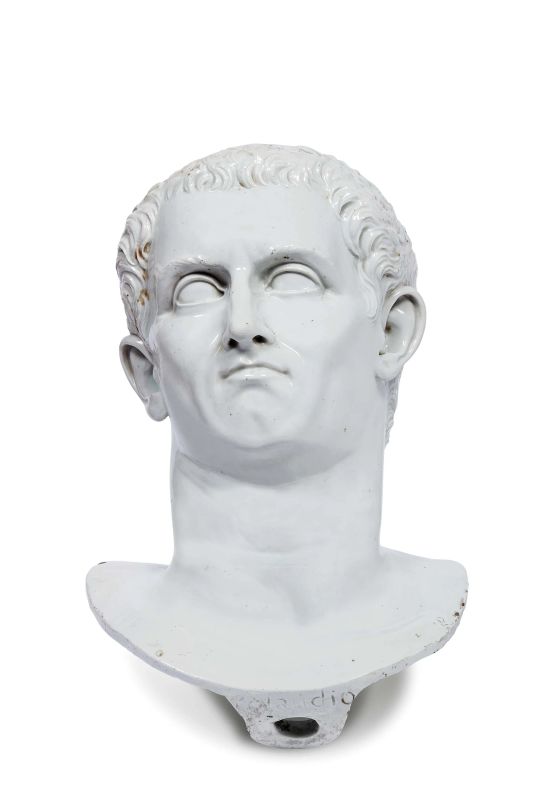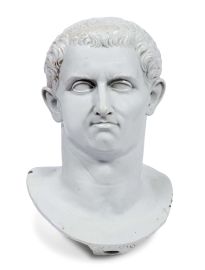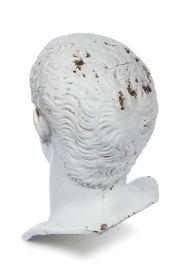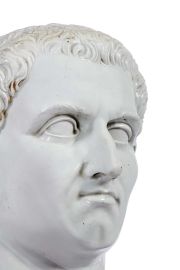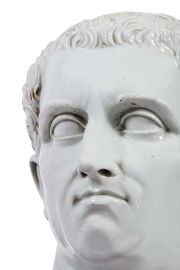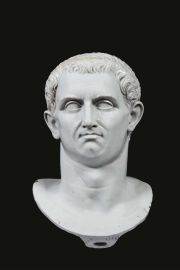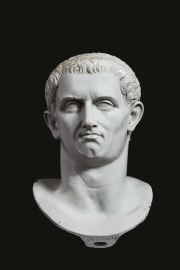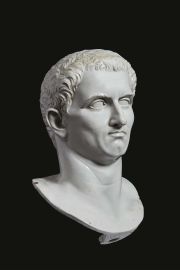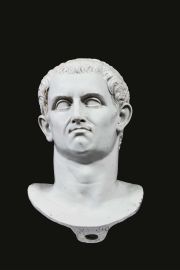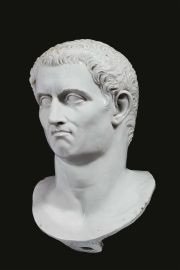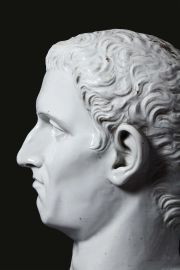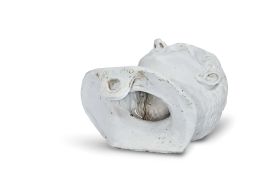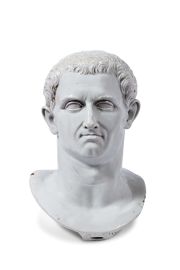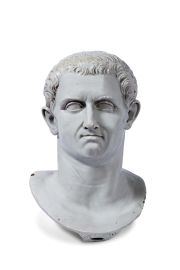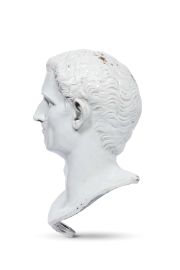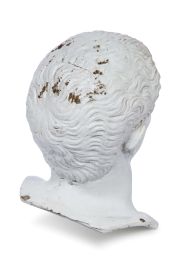BUSTO DI CLAUDIO, MANIFATTURA CARLO GINORI, DOCCIA, 1754-1760 CIRCA
BUST OF CLAUDIUS, MANIFATTURA DI DOCCIA, CA. 1754-1760
hard-paste porcelain and white glaze, 38x25x21 cm
The name ‘Claudio’ is stamped on the porcelain support tab designed to be inserted in the base.
Provenance
Collezione privata, Londra;
Asta Sotheby’s, Londra, 5 maggio 1970, lotto 15;
Collezione privata, Firenze
Reference Literature
L. Ginori Lisci, La porcellana di Doccia, Milano 1964;
M. Gregori, Cultura e genio di Carlo Ginori, in “Antichità Viva” 4.1965 (2), pp. 18–36;
K. Lankheit, Kunst des Barock in der Toskana, München (1976);
K. Lankheit, Die Modellsammlung der Porzellanmanufaktur Doccia. Ein Dokument italienischer Barockplastick, München 1982;
J. Winter (ed.), Le statue del marchese Ginori. Sculture in porcellana bianca di Doccia, Firenze 2003, pp. 42-45
J. Kraftner, C. Lehner-Jobst, A. d’Agliano (eds.), Baroque Luxury Porcelain, The manufactories of du Paquier in Vienna and of Carlo Ginori in Florence, München 2005;
R. Balleri (ed.), Carlo Ginori. Documenti e itinerari di un gentiluomo del secolo dei lumi, Firenze 2006;
A. Biancalana, Porcellane e maioliche a Doccia. La Fabbrica del Marchese Ginori. I primi cento anni, Firenze 2009;
A. Alinari, La porcellana dei Medici. Bibliografia ragionata e catalogo essenziale, Ferrara 2009;
T. Wilson, Medici porcelain, in D. Thornton and T. Wilson (eds), Italian Renaissance ceramics. A catalogue of the British Museum collection, London 2009, pp. 694–706;
D. Zikos, On the nature of moulds purchased and commissioned by Carlo Ginori, in “Quaderni Amici di Doccia”, 4. 2010, pp. 18–39;
R. Balleri, Sculpture at Doccia, in “Quaderni Amici di Doccia”, 4.2010, pp. 40–76;
R. Balleri, Modelli della Manifattura Ginori di Doccia. Settecento e gusto antiquario, Roma 2014;
H. Wirta Kinney, Transcribing material values in Doccia’s Porcelain Medici Venus, in A. Putzger, M. Heisterberg, S. Müller-Bechtel De Gruyter, Nichts Neues Schaffen, Creating Nothing New: Perspectives On The Faithful Copy, 1300–1900, Berlin- München 2018
This full-round portrait portrays a mature man, with accentuated expression lines around the mouth and on the cheeks and forehead but idealised nonetheless. The head, turned slightly to its proper right, is crowned by hair cut in a short fringe, as was the fashion in the Julio-Claudian age, leaving uncovered the small and well-proportioned ears. The face is set in a pensive frown, as often in official portraits of the emperor;(1) the thin lips are clamped shut, the nose is large, the bridge wide.
Comparison with two known works of the coeval Ginori production, the busts of Hadrian (1754) and of Trajan (1756), lead us to place this bust of Claudius very close to them in time and in technique: all share the manner in which the hair is drawn and such “imperfections” as reddish spots in the hair, marked firing defects which determine fissuring or flattening, an excess of blue-green glaze in several areas (for example inside the auricle), and finally the greyish tone of the paste with a scarce application of glaze, greenish-white in colour and perhaps still rich in lead. The nearly tenuous connection to the ancient model, the stylistic similarities between this bust and the porcelain bust of Emperor Tiberius and extension of the modelling to the upper chest and inclusion of a support tab lead us to date the piece to ca. 1755, when the manufactory began to supply portrait busts with bases, also in porcelain. Use of life-size models seems to us to be more adherent to the cast in later heads. All this suggests the hand of Gaspero Bruschi with Francesco Lici at work in the modelling of this porcelain work.
Working backwards, we find mention of our bust in the catalogue of an auction held in November 2010,(2) which proposed a head of Emperor Caligula – with the name incised beneath the tunic and matched with a non-coeval base – attributed to a model by Soldani Benzi. The description makes reference to two other porcelain busts which had appeared at auction, one in 1976, the other in 1970;(3) the latter, described as ‘a rare white Doccia head of Emperor Claudius after Massimiliano Soldani Benzi’,(4) is the bust we are presenting here, the provenance of which at the time was stated as being ‘from a gentleman’s collection’. Today, exactly 50 years later, it has finally resurfaced.
This ‘al naturale’ head of Emperor Claudius might be said to be making its return after a long absence.
The heads of the ‘Twelve Caesars’
Marchese Ginori’s cultural project fell solidly within in a period in history in which a marked intention to recover ancient works, whether original or merely inspired by antiquity, took hold and prospered; a period in which a sober linearity of forms well fit the demands of rationalism in the ‘Age of Enlightenment’.
Marchese Carlo Andrea Ignazio Ginori (1702-1757) founded his manufactory in 1737. With the collaboration of sculptor Gaspero Bruschi and in direct competition with the trade in statuary, he began producing porcelain replicas of ancient sculptures, a genre in great demand by the Grand Tour travellers for whom possession of antiquities and neoclassical works was a fundamental part of their social identity. These works, the majority of which were produced for the foreign markets, aroused a certain interest in Italy as well, due to the erudite significance of identifying with one’s culture of origin. Of interest in this connection, the words of Rita Balleri in the preface to her book: ‘Carlo Ginori behaved like a collector of his time and it is for this reason that his life-size casts should be considered a collection of antiquities and not studied solely as models used by the manufactory.’(5)
The Marchese’s ambition to make a true museum of his Galleria dei Modelli pushed him to establish contacts with numerous personages of the era whom he felt could aid him to find works to reproduce. The iconographic program for the gallery grew out of the two directions taken by his research: in part, it was directly inspired by original works and in part by copies already manufactured and successfully marketed.
While conducting his research into new models, Marchese Carlo Ginori had acquired from the heirs of sculptors Giovan Battista Foggini (1652-1725) and Massimiliano Soldani Benzi (1658-1740) several exemplars in wax and terracotta together with the casts of several bronzes. The selection of models reflects the taste of Prince Johann Adam Andreas I of Liechtenstein, a patron of Massimiliano Soldani Benzi, for whom the artist made two bronze statues (proposed in porcelain by Carlo Ginori about forty-five years later) as well as eight bronze busts, heads of Roman emperors drawn from originals in Florence with which the sculptor celebrated the Imperial portrait as a symbol of strength and virtue.
Ginori re-proposed Soldani Benzi’s compositional scheme in the important series of rare Doccia porcelain busts known as the ‘Twelve Caesars’. This assortment of portraits is mentioned in the Inventario dei Modelli published by Lankheit and is also listed in the manufactory’s 1760 price list as among the most costly of the products of the early years of Ginori’s activity (see Lankheit 1982, pp. 17-38; and Darr, Barner and Bostrom 2003, Vol. II, p. 96, nos. 170-171).
While demanding, the marketing of moulds and copies was a lucrative activity – as Bottari recalls a propos of the cast makers (formatori): ‘… ho saputo che questi formatori, gente del tutto simile agli altri artisti di Roma, hanno voglia di guadagnare assai, e di lavorare poco’ [I have learned that these cast makers, in all respects similarly to Rome’s other artists, want to earn much and work little] (AGL 1753, XX, letter 66, Guido Bottari to Carlo Ginori, Rome, 6 January 1753). The originals and the moulds from which copies could be made were well under the control of the owners, who were particularly careful to safeguard the works against damage. What is more, the copies themselves were renowned: a request for one of these works was considered proof of the good taste, wealth and power of the collector, who was generally a prince, a nobleman or a man of the cloth. Additionally, the value of the original was in no way diminished by reproduction but rather translated into a new form of power: in effect, the faculty to authorise production of copies and limit the number of moulds in circulation increased the value of both the copies and the original works.
A fundamental aid to understanding the formation of the iconography of these works is to be found in the Marchese’s epistolary exchanges with Guido Bottari, older brother of Msgr. Giovanni Gaetano Bottari (1689-1775), and with Giovanni Domenico Campiglia, superintendent for models at the Apostolic Camera and author of etchings of works in the Capitoline Museums. Of particular interest, the exchanges between the curators of the collections and Ginori’s chief modeller Gaspero Bruschi (1710-1780), who oversaw production and was ultimately responsible for all the porcelain statuary. Notably, this documentation points up how the parties had recourse to a great number of intermediaries to conclude their negotiations and arrive at actual production of the copies.
Support sought in Rome permitted Marchese Ginori to submit to his modeller Francesco Lici, known as Squarcione, some of the most important sculptures in the Roman collections (and specifically the Capitoline collection) for copying. The results obtained by Squarcione were truly striking, thanks in large part to Bruschi’s profound technical knowledge. A letter from Guido Bottari tells of the presence of a representative of Marchese Ginori as early as 1753: ‘Poco ci volse per farmi credere che non voleva dare la licenza che subito mandasse il Lici che appunto quel giorno aveva terminato di formare il terzo gruppo del signor Valle’ [It took little to convince me that he did not want to grant the licence, so I immediately sent Lici, who on that day had finished his work on Mr Valle’s third group] (AGL, 1753, XX, folio 69). In the summer of that same year, Lici returned to Doccia; afterwards, sculptors Bartolomeo Cavaceppi and Vincenzo Pacetti, and others, supplied Ginori with the models for his porcelains. The Marchese’s correspondence with high-profile personalities in Rome is ample. In 1753-1754, several crates containing plaster casts of models from ancient and newer models arrived from Rome. A letter dated 3 August 1754 documents shipping of 18 crates to the port of Livorno: ‘L’ordinario scorso diedi l’ordine di mandare a V. Ecc. la polizza di carico di cinque statue [...] il suo giovane ha cominciato a formare la sesta statua...’ [In the last order I asked that your Excellency be sent the bill of lading relative to five statues . . . his assistant has begun to cast the sixth statue . . .] with a ‘Nota delle casse che si spediscono di Livorno sulla Tartana del Pron. Fontana e a cura di Francesco Lici sopracarico: cassa n. 1) entrovi parte delle forme di Fauno di campidoglio e altri pezzi di forma; cassa n. 2) entrovi getto d’una statuina rappresentante un Camino comprato; […] n. 8) entrovi gli appositi busti comprati Alessandro Magno, Vergine Vestale, Faustina, Comodo, Messalina e inoltre un busto anonimo regalato da Bartolomeo Cavaceppi; […] cassa n. 12) entrovi forma di busto di Druso ; cassa n. 13) entrovi forma di busto di Settimio Severo; cassa n. 14 ) – ; cassa n. 15 ) entrovi i getti degli otto apostoli comprati ultimamente; cassa n. 16) entrovi le forme de busti di Silla, Zecnocrate, Calligola e della testa d’uno schiavo; cassa n. 17) entrovi il getto della statua di Antinoo; cassa n. 18) Forma di Statua di Alessandro Magno, del Putto col Cigno ed Ercole Fanciullo’ [Note of the crates sent to Livorno aboard Pron. Fontana’s tartana, overseen by Francesco Lici: crate n. 1) part of the moulds for the Capitol Faun and other parts of moulds; crate no. 2) purchased cast of a small statue of a Camino; […] no. 8) purchased busts of Alexander the Great, a Vestal Virgin, Faustina, Commodus, Messalina and an anonymous bust donated by Bartolomeo Cavaceppi; […] crate no. 12) mould for a bust of Drusus; crate no. 13) mould for a bust of Septimius Severus; crate no. 14 ) – ; crate no. 15 ) casts of last-purchased eight Apostles; crate no. 16) moulds for Sulla, Zecnocrate, Caligula and head of a slave; crate no. 17) cast of the statue of Antinous; crate no. 18) mould for the statues of Alexander the Great, Putto with a Swan and the Child Hercules].(6)
It is in these crates that we first note several Roman busts.
In July of 1754, chief modeller Bruschi informed the Marchese of the difficulties he encountered when using certain of Squarcione’s moulds for large statues: ‘a usare certe forme per le statue grandi [...] ha mandato ancora delle forme, ma se le fo di porcellana le sciupo, e ne perdiam la forma [...] per adesso farò certi busti alla meglio ch’ha mandato il medesimo da Roma’. Finally, a letter from Bruschi, dated 7 September 1754, tells us that from Rome he received twelve examples of ancient sculpture from the Capitoline collections: ‘confermando a V. Ecc.za che questa mattina sono state imbarcate due casse dirette a V. Ecc.za [...] in una di dette casse, cioè nella più grande, sono teste di dodici Cesari avute dal Signor Campiglia, in quella minore sono i getti dei gruppi del Bernino [confirming that this morning two crates addressed to Your Excellency were loaded onboard . . . in the larger of the two are the twelve heads of Caesars received from Mr Campiglia; in the smaller, the casts of the group by Bernino] (AGL,1754, 137,I,c 187r-v).
From these derived the models finished by Bruschi himself, who perfected the technique, again together with the formatore Squarcione: ‘Squarcione forma il Busto a testa di Adriano avendolo rifatto di terra, cosa che non si potrà il sfuggire a tutte quelle forme cavate dal Marmo. Per fare gli Altri busti delle teste che non l’Anno, è necessario avere il libro delle stampe del Mose Capitolino, che me fece tempo a mandare a Firenze, però Lo potrebbe far qua ritornare, per copiare gli altri busti’ [Squarcione shaped the bust of Hadrian, having cast it in clay as he did all those works sculpted in marble. To make the other busts for which we have no mould, we must possess the book of the prints which in its time I had sent to me in Florence, although it could be returned here in order to copy other busts] (AGL, file 137, II, c. 361v.) The head of Hadrian was thus the prototype; the other heads were moulded beginning in 1754 and probably until 1760. (7) We can deduce that the book of etchings of these works, made by Campiglia and sent by Giuseppe Gaetano Bottari to the Marchese, became a source of inspiration on a par with the plaster casts.
According to Lankheit, (8) these sculptures were considered a part of Ginori’s so-called al naturale production; at this point, we can reasonably affirm that ‘Twelve Heads’ – of Julius Caesar, Augustus, Tiberius, Caligula, Claudius, Nero, Galba, Otho, Vitellius, Vespasian, Titus, Domitian – were among the casts sent from Rome. In a letter dated 27 March 1756, Abbot Bottari wrote to Carlo Ginori about other heads: ‘mi sono abboccato con detto Signor Cavaceppi, e dato che il prezzo de consaputi Busti de Cesari era parso grave, ho procurato di restringerlo quanto ho potuto riducendolo alla pura spesa della fattura, e gesso’ [I spoke with Mr Cavaceppi and given that the price of the well-known Busts of the Caesars seemed high, I attempted to lower it as I could, reducing it to the sole cost of production plus the plaster]; and in an attachment describes the three busts: ‘forma della testa di Marco Aurelio vecchio, Getto di testa con Busto di Antonino Pio, Getto della testa con busto di Traiano’ [cast of the head of Marcus Aurelius as an old man, cast of a head and shoulders portrait of Antoninus Pius, cast of a head and shoulders portrait of Trajan] (AGL, Ginori Sen. Carlo. Miscellaneous letters addressed to him. 1756, file no. 24 XII, 5, c. 111). This assortment also included heads of Commodus, Antoninus Pius and Sulla, listed in the inventory, for a total, therefore, of eighteen ‘life size heads of the Caesars’ (9), later cited in the lists drawn up at the death of Carlo Ginori and in any case included in the 1760 inventory/price list as ‘Teste di Cesari di grandezza naturale modellate dagli originali del Campidoglio colla loro base di porcellana bianca’ [Life-size white porcelain Heads of the Caesars modelled from the originals at the Campidoglio, with bases].
After 1760, French fashion dictated a change in production strategies and the consequent abandonment of the statuary models in favour of smaller figures and bas-reliefs. We are nevertheless certain that heads of the Caesars were indeed manufactured, since in the 1765 inventory, drawn up to document the works in the Livorno storehouses between 1757 and 1765, there appears the entry: ‘2 Teste di Cesari’.
Porcelain versions of some of the Heads of the Caesars are known today: Julius Caesar (formerly in the Costantini collection, Rome); Augustus (Minneapolis Institute of Art); Tiberius (private collection, Milan); Otho (private collection); Vitellius (recently seen on the market, formerly in the collection of the Edward James Foundation, Chichester); Vespasian (recently seen on the market, formerly in the collection of the Edward James Foundation, Chichester); Caligula (seen on the New York market in 2010). Furthermore, heads of Hadrian (1754) and of Trajan (1756) are known to be currently in private collections; the fates of the heads of Nero, Galba, Domitian, Marcus Aurelius, Commodus, Antoninus Pius and Sulla are instead unknown.
1) The recent exhibition entitled Claudio Imperatore. Messalina, Agrippina e le ombre di una dinastia, at the Museo dell’Ara Pacis in Rome, is an interesting source as concerns reassessment of the figure of the emperor and his iconography. This bust shows similarities not only to the Capitol portraits but also to official portraiture which depicts an idealised emperor in the guise of Jupiter or triumphally nude, as in the statues at the Pio-Clementino Museum, the Vatican Museums and the Musée du Louvre, but a coincidence which entirely justifies use of the plaster cast is still missing.
2) Sotheby’s, Important French Furniture, Ceramics and Carpets including Property from the Estate of Mrs. Robert Lehman, New York, 18 November 2010, lot 1.
3) Sotheby’s, Catalogue of fine continental porcelain, London, 5 May 1980, lot 15.
4) The portrait does not seem to match any of the busts of Roman emperors held by the Uffizi and now at the Museo Archeologico Nazionale of Florence, on which we know the Florentine sculptor drew for his models.
5) R. Balleri, Modelli della manifattura Ginori di Doccia. Settecento e gusto antiquario. Romea 2014, preface.
6) A. Biancalana, 2009, pp. 81-82.
7) D. Zikos, in J. Kraftner, C. Lehner-Jobst, A. d’Agliano, 2005, p. 401.
8) Lankheit 1982, pp. 17-38.
9) Biancalana 2009, pp. 99-100.


